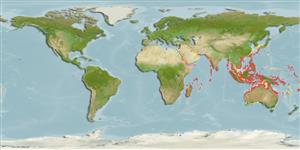Gastropoda |
Littorinimorpha |
Strombidae
Environment: milieu / climate zone / djupintervall / distribution range
Ekologi
; djupintervall 1 - 37 m (Ref. 100968). Tropical
Indo-West Pacific: from central East Africa, to Sri Lanka; from Andaman and Nicobar Islands to eastern Melanesia; north to Japan and south to Queensland and New Caledonia.
Length at first maturity / Size / Weight / Age
Könsmognad: Lm ? range ? - ? cm Max length : 5.0 cm SHL hane/ej könsbestämd; (Ref. 349); common length : 4.0 cm SHL hane/ej könsbestämd; (Ref. 349)
Mainly collected for shellcraft, where the species is abundant (Ref. 349). Found on shallow waters, on weeds and sand (Ref. 799). Also occurs in shallow subtidal waters (Ref. 349).
Life cycle and mating behavior
Könsmognad | Reproduktion | Lek | Eggs | Fecundity | Larvae
Members of the order Neotaenioglossa are mostly gonochoric and broadcast spawners. Life cycle: Embryos develop into planktonic trocophore larvae and later into juvenile veligers before becoming fully grown adults.
Poutiers, J.M. 1998 Gastropods. p. 363-648. In Carpenter, K. E. and V. H. Niem. 1998. FAO species identification guide for fishery purposes. The living marine resources of the Western Central Pacific. Volume 1. Seaweeds, corals, bivalves, and gastropods. Rome, FAO. (Ref. 349)
IUCN Red List Status
(Ref. 130435: Version 2025-1)
CITES status (Ref. 108899)
Not Evaluated
Not Evaluated
Threat to humans
Harmless
Human uses
| FishSource |
Verktyg
Ytterligare information
Trophic EcologyFood items (preys)
Födosammansättning
Födointag
Predatorer
Population dynamicsTillväxtMax. ages / sizesLength-weight rel.Length-length rel.Length-frequenciesMass conversionAbundans PhysiologySyreförbrukning
Human RelatedStamps, coins, misc.
Internet-källor
Estimates based on models
Preferred temperature
(Ref.
115969): 24.7 - 29.1, mean 28.2 (based on 1088 cells).
Fishing Vulnerability
Low vulnerability (10 of 100).
